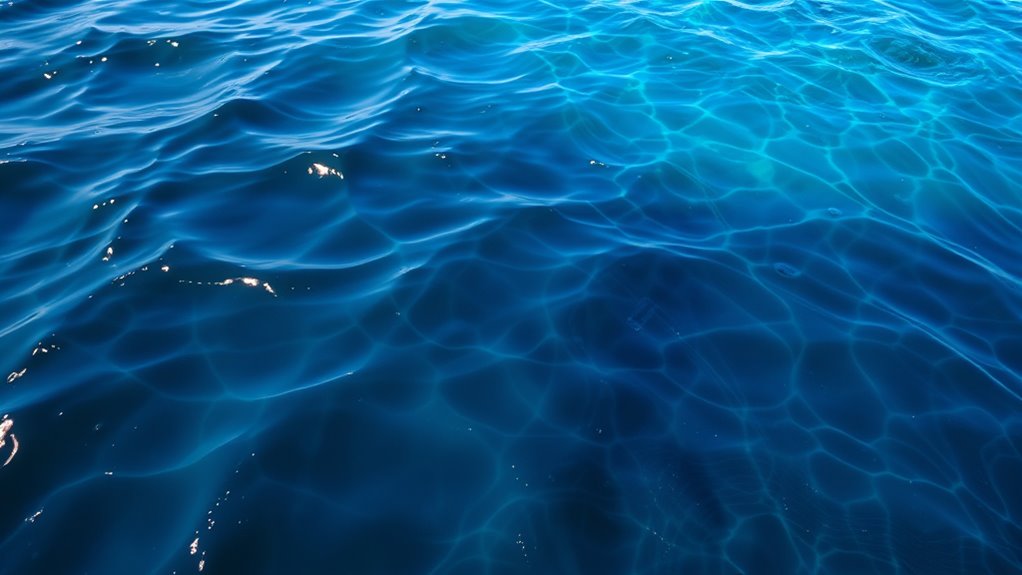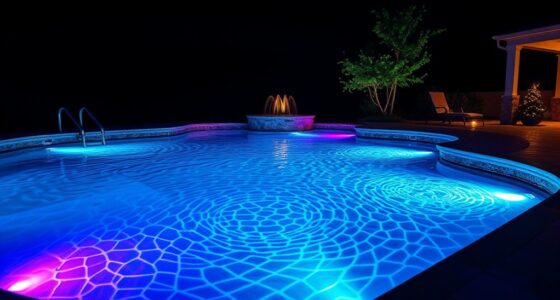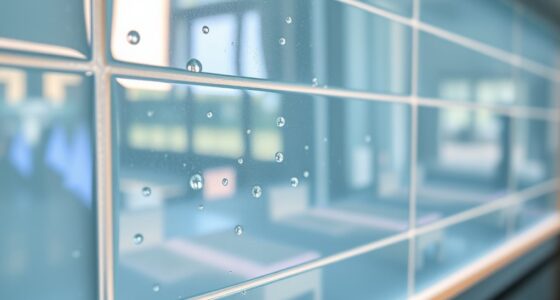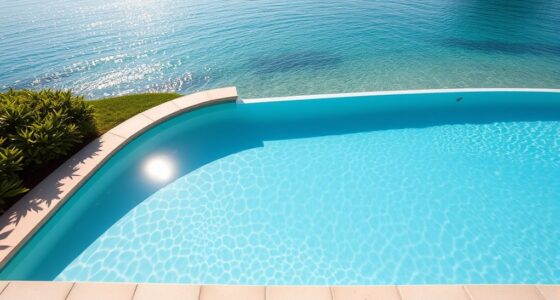Dark and light blue water finishes have distinct effects on space perception, mood, and ambiance. Light blues reflect more light, making a room feel larger, open, and energetic, while dark blues absorb light, creating intimacy, stability, and calmness. These finishes also influence emotional responses—light blues promote openness and creativity, whereas dark blues evoke confidence and reflection. Understanding how these shades interact with light and culture helps you craft the perfect environment; explore further to uncover more insights.
Key Takeaways
- Light blue finishes enhance space perception by reflecting more light, making rooms appear larger and more open.
- Dark blue finishes create intimacy, depth, and stability, receding visually to add depth and focus within a space.
- Light blues evoke openness, calmness, and approachability, while dark blues convey confidence, reliability, and authority.
- The color science of blue water tones influences emotional responses, with light tones promoting energy and dark tones fostering relaxation.
- Proper use of shades manipulates spatial dynamics and mood, balancing visual perception with psychological effects.
The Psychology of Blue Water Tones

Blue water tones evoke a sense of calm and tranquility, making them a popular choice in design to create relaxing environments. When you incorporate these hues, you tap into their psychological power to soothe your mind and reduce stress. Light blues often evoke feelings of openness and clarity, helping you feel more at ease and mentally refreshed. Darker shades, on the other hand, can bring a sense of stability and depth, encouraging focus and introspection. Whether used in a home or workspace, blue water tones influence your mood by promoting serenity and emotional balance. They connect you to nature, evoking the vastness of the sky and ocean, which naturally calms your nervous system and fosters a sense of peace. Color psychology plays a crucial role in how these tones affect your emotional well-being.
Visual Perception of Dark Versus Light Finishes
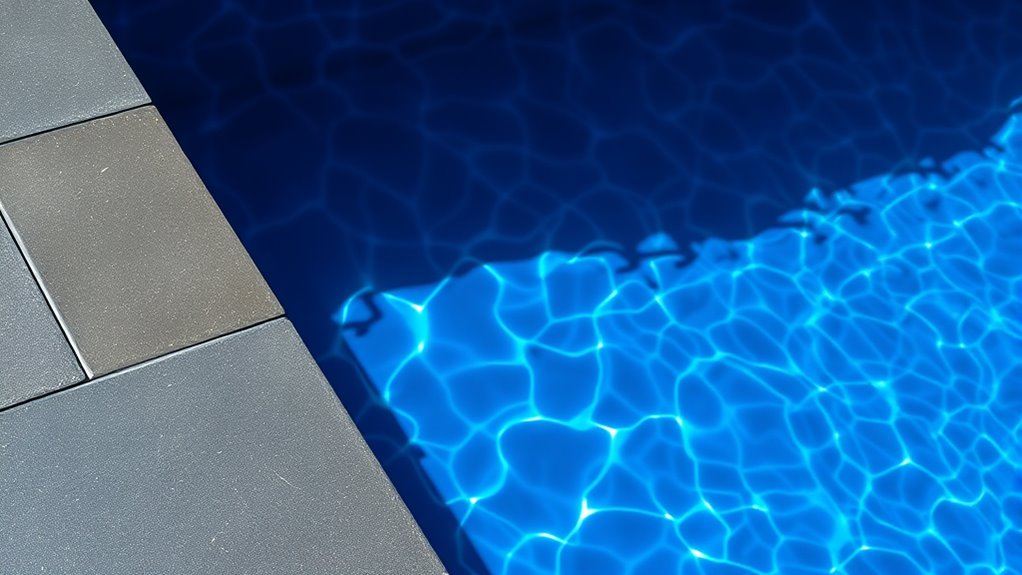
When choosing dark or light finishes, you’ll notice how contrast and clarity affect the overall look of a space. Lighter shades can enhance depth perception, making a room feel more expansive, while darker tones may create a cozy, intimate vibe. Understanding how these finishes influence the illusion of space can help you make more confident design choices. Additionally, awareness of visual perception principles can guide selections to optimize room ambiance and spatial dynamics.
Contrast and Clarity
Dark finishes often create a striking contrast that enhances clarity and draws attention, making details stand out more prominently. This boldness can make your space feel more defined and impactful. When using dark finishes, you evoke a sense of depth and intensity that commands focus. Consider these emotional benefits:
- Feel empowered by the commanding presence of bold, dark hues that make your design unforgettable.
- Experience calm and sophistication as dark finishes create a sense of stability and timelessness.
- Ignite curiosity and excitement through the high contrast that highlights every small detail vividly.
- Incorporating color science principles can help you understand how light and dark finishes influence perception and mood.
Depth Perception Effects
The way finishes influence your perception of space hinges considerably on their depth perception effects. Lighter finishes tend to advance, making a surface appear closer and more prominent. This effect can create a sense of openness and airiness, as your eyes interpret the lighter area as nearer. Conversely, darker finishes tend to recede, giving the impression that a surface is farther away or deeper within the space. This depth perception plays a pivotal role in how you experience a room’s dimensions. For example, dark blue water finishes may seem to sink or recede, enhancing the feeling of depth and distance. Understanding these effects helps you choose finishes that manipulate space perception, whether you aim to enlarge a room or add layers of visual depth.
Illusion of Space
Light finishes create the illusion of a larger, more open space because they reflect more light and draw the eye outward. When you choose lighter shades, your room feels brighter, airier, and more inviting. The increased reflection tricks your mind into perceiving extra space, making small rooms seem bigger. Additionally, incorporating natural materials like linen and wood can enhance this effect by adding texture without overwhelming the space. Conversely, darker finishes absorb light, causing walls to recede and spaces to feel more intimate or enclosed.
Color Temperature and Its Emotional Effects
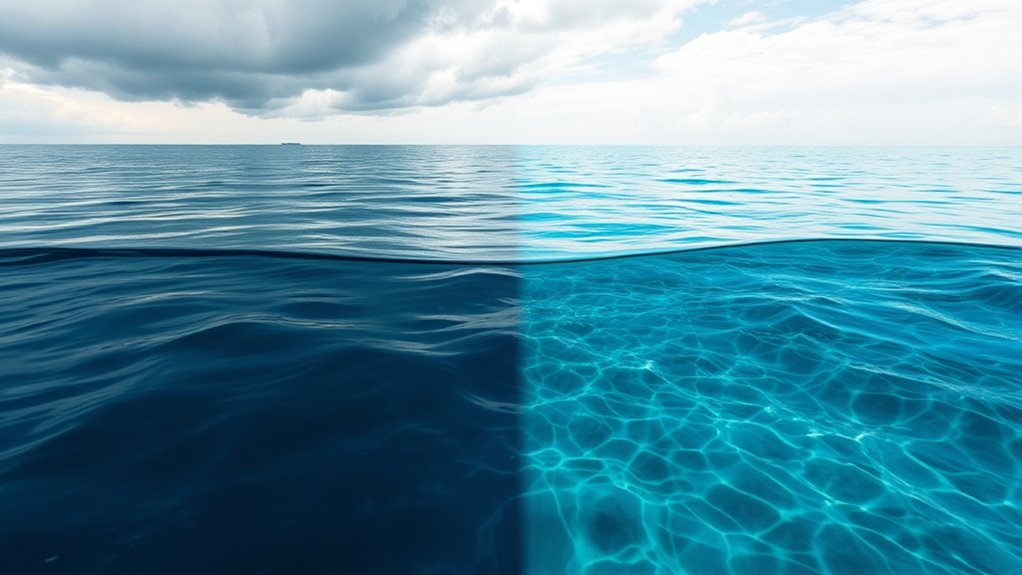
Color temperature plays a essential role in shaping the emotional atmosphere of a space, influencing how you feel when you enter a room. Warm tones, like soft yellows and amber, create a cozy, inviting environment that makes you feel relaxed and comfortable. They stimulate feelings of warmth and intimacy, perfect for living rooms or bedrooms. Cooler tones, such as bluish whites and daylight hues, evoke a sense of calm, clarity, and focus. These shades can energize a space or promote concentration, making them ideal for work areas or kitchens. Your emotional response depends heavily on the color temperature you choose; warmer finishes foster comfort, while cooler finishes promote alertness. Additionally, the color vibrancy of a finish can impact its emotional effect, with more vibrant shades energizing or stimulating a space. Understanding this relationship helps you craft spaces that align with the mood you want to establish.
Light Reflection and Its Impact on Space
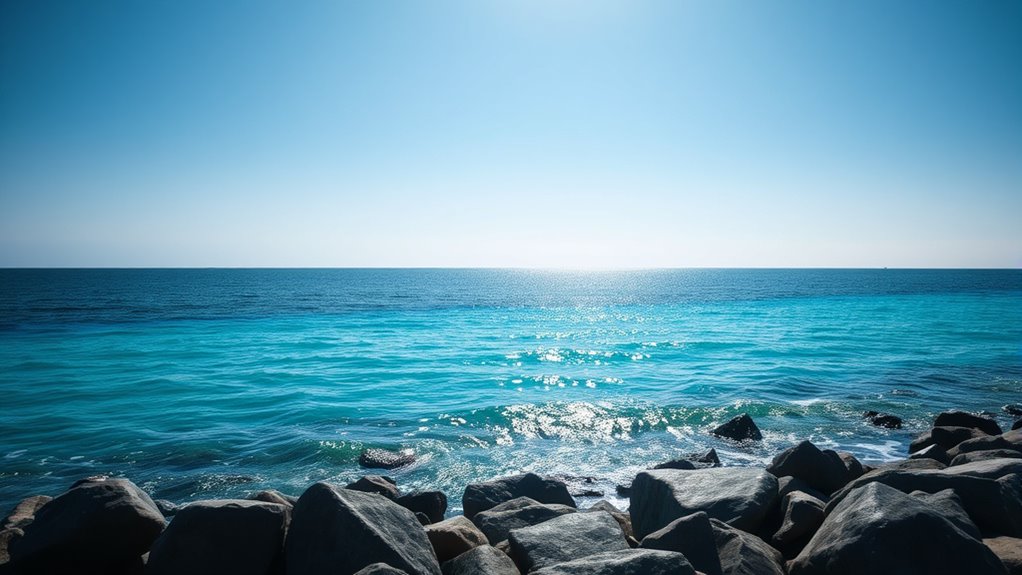
Reflecting light can dramatically alter the perception of a space, influencing how open, bright, or cozy it feels. When you choose lighter finishes, they bounce more light around, making a room seem larger and more inviting. Conversely, darker finishes absorb light, creating an intimate, calming atmosphere.
Consider these effects:
- Enhanced brightness: Light finishes amplify natural light, energizing your space.
- Sense of openness: Reflective surfaces expand boundaries, reducing feelings of confinement.
- Warmth or coolness: The way light reflects can emphasize either cozy warmth or crisp coolness, shaping your mood.
Understanding how light interacts with your finishes helps you craft a space that feels just right for your emotional needs.
Depth and Dimension in Blue Water Finishes
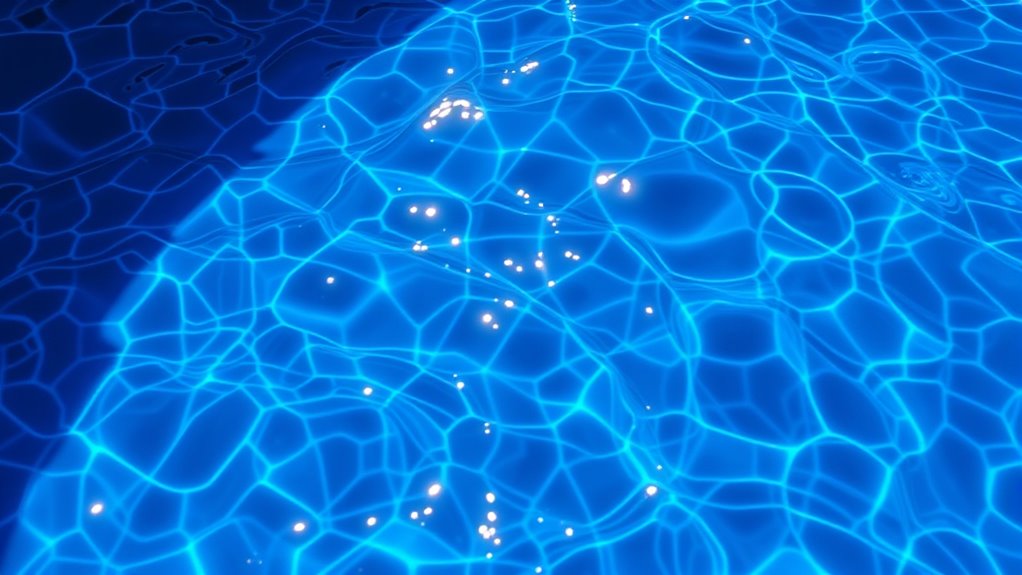
To create a sense of depth and dimension in blue water finishes, you can layer different shades and textures to mimic the natural movement of water. Using varying tones—from deep navy to soft aqua—adds visual interest and makes your space feel alive. Incorporate textures like gloss, matte, or subtle shimmer to enhance the illusion of movement and depth. The key is to blend these elements thoughtfully, creating a dynamic, layered effect that draws the eye in. Additionally, understanding sound vibrations and their influence on perception can inspire more immersive design choices that evoke a sense of calm and vitality. Below is a table illustrating how different shades and finishes evoke emotion:
| Shade | Texture | Emotion |
|---|---|---|
| Deep navy | Matte | Calm, stability |
| Turquoise | Glossy | Energy, freshness |
| Soft aqua | Satin | Serenity, openness |
Psychological Associations With Dark and Light Blues
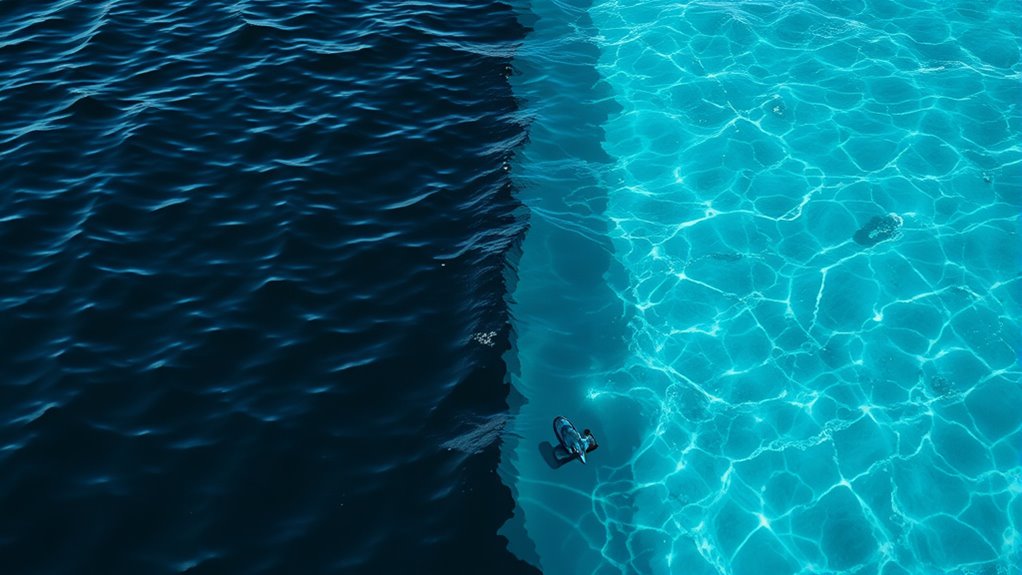
Dark blues often evoke feelings of trust and reliability, making them a popular choice for establishing confidence. Light blues, on the other hand, promote calmness and inspire creativity and energy. Understanding these psychological associations can help you choose the right finish to match your desired atmosphere. Additionally, the color science behind blue water highlights how different shades can influence perception and mood.
Calm vs. Energy
While both dark and light blues are popular choices in interior design, they evoke very different psychological responses. Dark blues tend to create a sense of calm and stability, helping you feel relaxed and centered. In contrast, light blues generate energy and freshness, making spaces feel lively and invigorating. Additionally, the horsepower of electric dirt bikes can influence the overall feeling of dynamism and vitality in a space, paralleling how different shades of blue impact mood.
Trust and Reliability
Blue hues are often associated with trust and dependability, making them popular choices in corporate branding and professional spaces. Light blues evoke openness and clarity, suggesting honesty and transparency. Dark blues convey strength and stability, reinforcing reliability and authority. These associations shape how you perceive brands and environments. For example, a light blue logo might feel approachable, while a dark blue suit communicates confidence. Here’s a quick comparison:
| Trait | Light Blue | Dark Blue |
|---|---|---|
| Trust | Friendly, transparent | Steady, authoritative |
| Reliability | Honest, approachable | Dependable, secure |
| Emotional tone | Calm, soothing | Serious, professional |
| Usage example | Customer service websites | Financial institutions |
Understanding these subtle cues helps you select the right blue for your message. Recognizing color psychology can further enhance your branding choices and influence perceptions.
Creativity and Inspiration
Light and dark shades of blue influence your sense of creativity and inspiration in distinct ways. Lighter blues often evoke calmness and openness, making your mind more receptive to new ideas. They create a peaceful environment that encourages imaginative thinking. Darker blues, on the other hand, tend to inspire focus and depth, fueling your determination and problem-solving skills.
To harness this, consider these emotional triggers:
- Light Blue: Sparks curiosity and invites fresh perspectives.
- Dark Blue: Fosters concentration and strategic thinking.
- Balanced Blues: Combine calmness with focus, enhancing your overall creative flow.
Additionally, understanding the personality traits associated with different shades can help tailor your environment to maximize potential. Choosing the right shade can disclose your potential, guiding your ideas from conception to realization.
Cultural Significance of Blue Water Hues

Throughout many cultures, blue water hues symbolize more than just the color of the sea; they embody deep spiritual and emotional meanings. In ancient Egypt, blue represented protection, life, and divine power, often seen in jewelry and art. For the Greeks, it signified clarity and calm, reflecting the importance of the sea in their mythology and daily life. In Asian traditions, blue water evokes tranquility, balance, and harmony with nature. Indigenous peoples associate blue waters with spiritual cleansing and connection to ancestors. Across cultures, blue water hues often symbolize stability, trust, and introspection. Recognizing these meanings helps you appreciate how color influences cultural identity and emotional well-being, shaping perceptions and responses to the natural world around you.
Practical Considerations for Using Finishes in Design
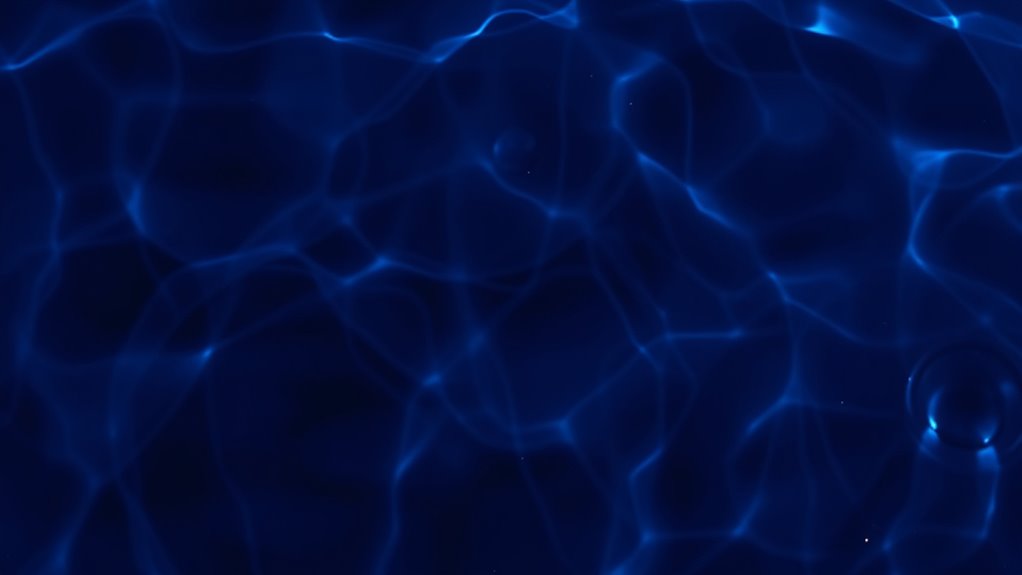
When selecting finishes for a space, understanding their practical aspects can make a significant difference in achieving your desired look and durability. Consider how finishes will hold up over time and under daily use. Factors like maintenance, resistance to wear, and environmental impact are vital.
Choosing finishes wisely ensures lasting beauty and durability in your space.
Here are three key considerations to keep in mind:
- Durability and Wear Resistance: Choose finishes that can withstand frequent contact and cleaning without fading or chipping.
- Maintenance and Cleaning: Opt for finishes that are easy to clean and require minimal upkeep to keep your space looking fresh.
- Environmental Impact: Select eco-friendly options that promote healthier indoor air quality and align with sustainable practices.
Being mindful of these practical aspects ensures your design remains beautiful and functional long-term.
How Light and Dark Finishes Influence Mood and Behavior
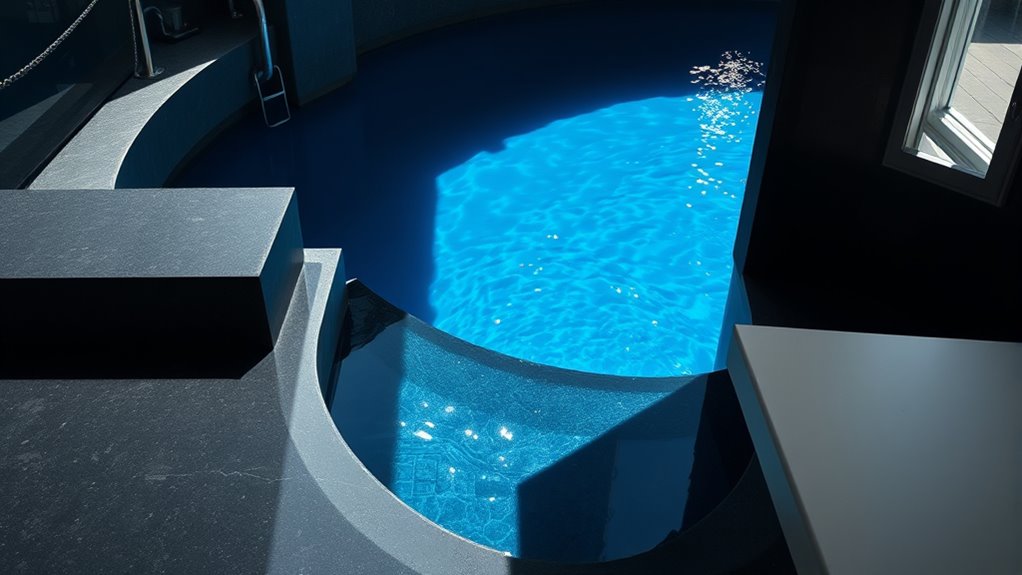
Finishes in your space can considerably shape the mood and influence how people behave within it. Light finishes often create an open, energetic atmosphere, encouraging activity and positivity. Dark finishes, on the other hand, evoke warmth, intimacy, and calmness, promoting relaxation or focus. Your choice impacts emotions and social interactions. For example, a bright room can boost creativity, while a darker space fosters reflection. Consider the following effects:
| Finish Type | Mood and Behavior Impact |
|---|---|
| Light | Uplifting, alertness, socializing |
| Dark | Cozy, focused, calming |
| Light | Invigorates, enhances openness |
| Dark | Encourages introspection |
| Mixed | Balance of energy and calmness |
Choosing the right finish aligns your environment with the desired emotional response.
Frequently Asked Questions
How Do Different Lighting Conditions Alter Blue Water Finish Appearances?
Different lighting conditions markedly change how blue water finishes appear. Under bright, natural sunlight, the finish looks more vibrant and shimmering, highlighting its depth. In dim or artificial light, it may seem muted or dull, losing some of its brilliance. You might notice subtle shifts in color and texture depending on the angle and intensity of the light. Adjusting your lighting setup can help you achieve the desired visual effect for your space.
Can Dark or Light Blue Finishes Affect Room Temperature Perception?
Dark blue finishes can make a room feel warmer because they absorb more light and heat, creating a cozy, intimate atmosphere. Light blue finishes reflect more light, making the space seem cooler and more open. You’ll notice this effect especially under direct sunlight or bright lighting. Choosing between them depends on whether you want to create a warmer, snug environment or a cooler, airy feel in your room.
Which Finishes Are More Suitable for High-Humidity Environments?
You should choose light blue finishes for high-humidity environments because they tend to reflect more moisture and are less liable to heat absorption. Light shades help keep the space feeling cooler and more comfortable, especially in moist conditions. Plus, they hide water spots and mold better than darker finishes, making maintenance easier. Opting for lighter hues ensures the space stays fresh, bright, and better suited to humid climates.
How Do Finishes Influence the Perceived Size of a Space?
Finishes dramatically influence how you perceive space—light finishes make rooms feel larger, while dark finishes add coziness. Imagine walking into a room painted in crisp, light hues; your eyes naturally stretch the space, creating an airy feel. Conversely, deep, dark finishes draw you in, making the room seem more intimate and compact. You can harness this effect to craft the perfect ambiance, whether you desire openness or warmth.
Are There Specific Blue Water Hues That Promote Relaxation or Alertness?
Certain blue water hues can boost relaxation or alertness. Soft, muted blues like powder or pastel shades create a calming atmosphere, helping you unwind and feel peaceful. In contrast, vibrant, saturated blues such as turquoise or cobalt stimulate alertness and focus, energizing your space. You should choose the hue based on your desired mood—softer blues for tranquility, brighter ones for activity.
Conclusion
Understanding the psychology and perception of blue water finishes helps you make more intentional design choices. Light blues can boost your mood and create a sense of calm, while dark blues add depth and sophistication. Remarkably, studies show that environments with blue hues can improve focus and reduce stress by up to 20%. By balancing these finishes thoughtfully, you shape spaces that influence emotions and behavior, making your design both beautiful and impactful.
